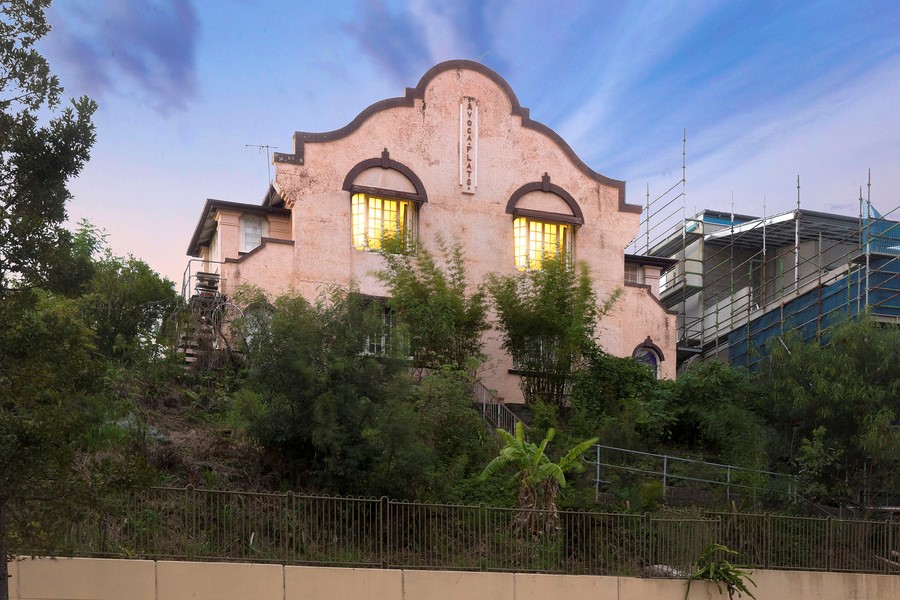Addresses
Type of place
Flat building
Period
Interwar 1919-1939
Style
Spanish Mission
Addresses
Type of place
Flat building
Period
Interwar 1919-1939
Style
Spanish Mission
Avoca Flats were constructed in 1935 by builder, Walter Maskrey, as an investment property. The set of eight flats follow the then popular ‘Spanish Mission’ style and holds a prominent landmark position on the hill above Breakfast Creek Road. Avoca Flats are important in demonstrating Brisbane’s development pattern in the interwar period, in particular in Bowen Hills, and the way in which ideas about acceptable forms of housing were changing.
Lot plan
L10_RP10117; L9_RP10117
Key dates
Local Heritage Place Since —
Date of Citation —
People/associations
Walter Maskrey (Architect)Criterion for listing
(A) Historical; (E) AestheticInteractive mapping
Lot plan
L10_RP10117; L9_RP10117
Key dates
Local Heritage Place Since —
Date of Citation —
People/associations
Walter Maskrey (Architect)Criterion for listing
(A) Historical; (E) AestheticInteractive mapping
History
As the Great Depression progressed in the late 1920s and into the 1930s a marked deficit of housing in Brisbane emerged. This was the period in which the multi-unit dwelling began to emerge as an alternative to the traditional Brisbane house and yard. Prior to this in larger Australian cities such as Sydney and Melbourne this style of ‘modern’ living, in blocks of flats, had become a stylish alternative to living in the traditional house.
In the early 1930s to cater for the housing shortage as well as to generate income many home owners in the inner-city suburbs converted houses into tenements, where tenants would share bathrooms, toilets and kitchens. This led to community concerns of overcrowding and increased hygiene problems. A fashionable and more sophisticated alternative to this form of accommodation was the purpose built block of self-contained flats. Marketed mainly at single people and childless couples the earliest self-contained flats in Brisbane were generally conveniently situated close to trams, trains and shopping facilities in inner-city suburbs such as Spring Hill, New Farm and Fortitude Valley.
The Brisbane City Council, in 1930, defined the flat as “a fully self-contained dwelling, with private kitchen, bathroom and water closet”. The flat was designed to be an independently functioning dwelling. Although seen as a sophisticated lifestyle, flat living was fairly uncommon in Brisbane in this period, with only 8.4% of Brisbane residents living in flats. This low percentage may be due to the economic constraints of the time as well as the perceived novelty of this style of living. Most interwar flats in Brisbane were architecturally designed and constructed from good quality brick and timber.
In 1935 Walter Maskrey, a Brisbane builder, purchased 32 perches of land, overlooking Breakfast Creek Road. The property was ideal for flats as it was close to the tram route along Breakfast Creek Road and situated high on the hill which would ensure breezes for each of the flats. It is unclear whether Maskrey commissioned an architect to design the flats. They had almost been completed by May 1935 and were advertised in the Telegraph:
“Inspect the beautiful Avoca Flats … Now nearing completion. The first and last word in Furnished Brick Flats. Glorious high healthy position, Glorious views, Glorious flats”.1
The benefits of the high position, overlooking Breakfast Creek Road and out to Newstead and the Brisbane River, was one of the benefits advertised. Each flat consisted of one bedroom and a study and although not advertised as such, according to Bennett’s thesis on interwar flats, could be described as Bachelor flats, that “usually comprised little more than a single bed-sitting room with kitchenette, plus bathroom and water closet” (Bennett, Interpreting the Modern: Flatland in Brisbane 1920-1941, Phd Thesis, Griffith University, 2010). By 1937, all but two of the flats had been tenanted.
Avoca Flats are a good example of a set of Spanish Mission interwar flats that continue to hold a prominence high above Breakfast Creek Road, overlooking the Newstead area.
Description
Avoca Flats are a set of timber and masonry interwar flats situated on the high ridge above Breakfast Creek Road, overlooking the Newstead area. The set of flats are two-storey consisting of four flats on each floor. The decorative parapet has been designed in the ‘Spanish Mission’ style and is stucco with exaggerated texture. The name of the flats, ‘Avoca Flats’, appears on the parapet. Much of the interwar features remain both on the exterior and in the interior.
Statement of significance
Relevant assessment criteria
This is a place of local heritage significance and meets one or more of the local heritage criteria under the Heritage planning scheme policy of the Brisbane City Plan 2014. It is significant because:
References
-
Telegraph, 29 May 1935
-
Architectural and Building Journal of Queensland, March 1936 and editorial, 1938
-
Brisbane City Council Minutes, 1935-36, p.764 & 918 and 1938, p.605
-
Brisbane City Council, 1946 aerial photographs.
-
Brisbane City Council Metropolitan Water Supply and Sewerage Board, Detail Plans
-
Certificates of Title, Department of Environment and Resource Management
-
McKellar's Map of Brisbane and Suburbs. Brisbane: Surveyor-General’s Office, 1895
-
Queensland Post Office Directories
-
Queensland Electoral Rolls
-
Brisbane City Council, Register of New Buildings, August
-
Bennett, Interpreting the Modern: Flatland in Brisbane 1920-1941, Phd Thesis, Griffith University, 2010
Citation prepared by — Brisbane City Council (page revised September 2020)

